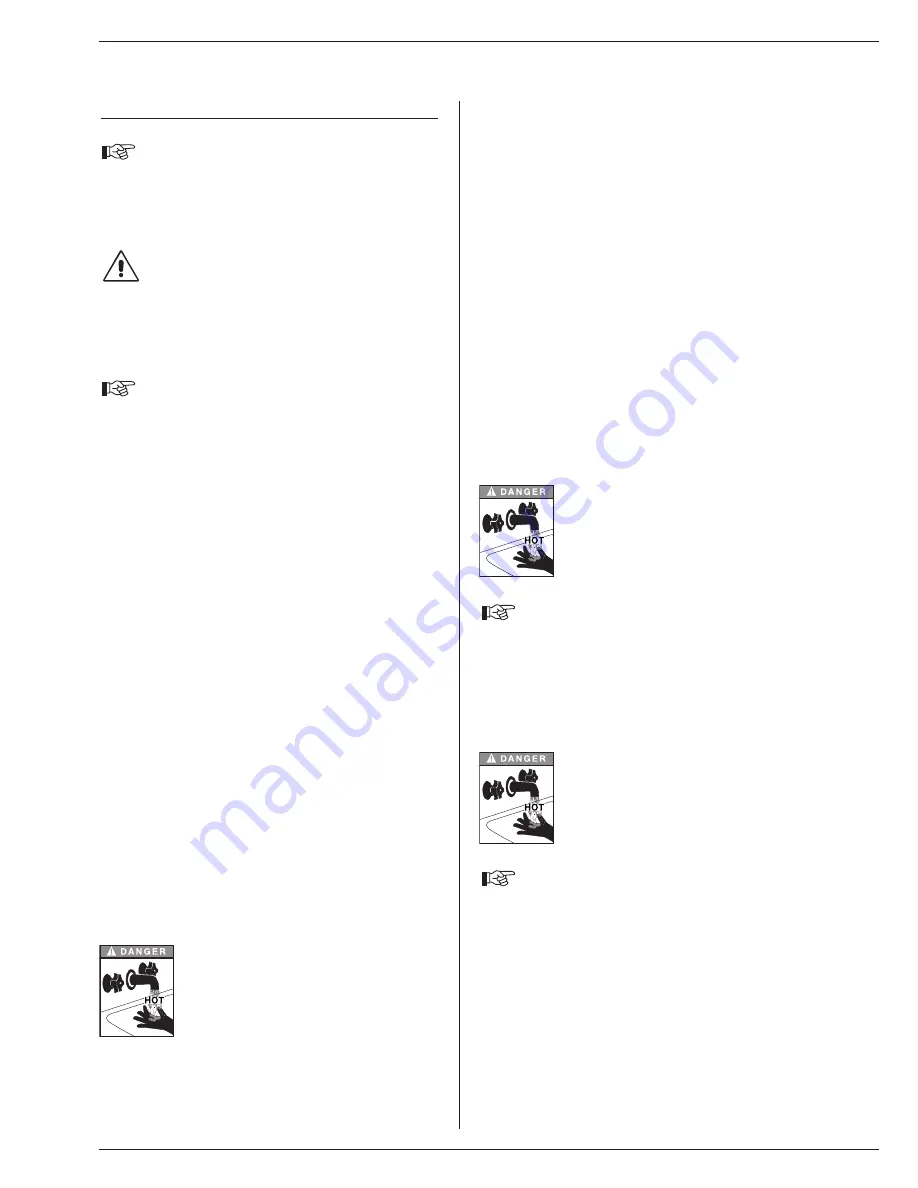
14
7 - Safety thermostat
When the temperature in the boiler exceeds 103 °C, the manually
reset safety thermostat is started up.
8 - Boiler shutdown indicator light
This light is lit when the safety thermostat starts up or when the
water pressure in the boiler is too low.
Central heating system gauge pressure
Your boiler is fitted with a central heating safety valve, set to 3 bar,
and with a pressure gauge.
First make sure that the water in the system is still pressurised.
When cold and after the air in the system has been bled, the
pressure gauge should show a pressure of between 1 and 2,
depending on the height of the building: (1 bar = 5m / 1.5 bar = 10
m and 2 bar = 15 m). To add water, open the filling valve (Fig. 2a and
2b on page 3). Make sure that the drain cock is properly closed after
filling and isolate the filling circuit from the central heating circuits.
Bleed the air in the system to get an accurate water pressure
reading.
Safety valve (central heating)
A monthly inspection is recommended:
Lift the lever on the emptying device for a few seconds to ensure that
the safety valve is working properly
The water which may flow out of the safety
valve is very hot and may cause serious burns.
The pipe discharging into the waste water
disposal system should be open to the
atmosphere.
Make sure there is nobody near the flow of hot
water.
If you notice anything unusual after this short trial,
please inform the installing engineer.
Safety unit (domestic hot water)
A monthly inspection is recommended:
Lift the lever on the emptying device for a few seconds to ensure that
the safety valve is working properly.
The water flowing out of the safety unit may be
extremely hot.
The pipe discharging into the waste water
disposal system should be open to the
atmosphere.
Make sure there is nobody near the flow of hot
water.
If you notice anything unusual after this short trial,
please inform the installing engineer.
USER GUIDE
USING THE BOILER
Your system should be serviced at least once year by
a qualified engineer.
If the boiler is subject to heavy use, it may require
servicing more than once a year - consult your service
engineer for advice.
Before carrying out any work on the boiler, switch the
power off at the mains switch fitted in the boiler room
by the electrician.
Understanding the control panel
There are no user parts inside
the control panel.
1 - ON/OFF switch
This must be used to switch the boiler off before carrying out any
work on it.
2 - Power selection switches
The control panel is fitted with two switches allowing the user to
select the boiler power according to his needs.
When only the first switch is pressed down, the boiler power is
limited to the first stage using +/- half of the power (ideal in summer).
In order for the boiler to run at full power, both of the switches must
be pressed down.
3 - Summer/Winter selector switch
“Winter” position: provides both domestic hot water and central
heating functions. “Summer” position: The central heating circulator
is switched off. Only the domestic hot water function is provided. If
there is not enough hot water available, we recommend setting the
thermostat (9) to a higher value.
When the weather turns cold again, simply select “Winter” to
reactivate the heating system.
4 - Controller
Please see the enclosed instructions if you have chosen this option.
5 - Mano-thermometer
Reads the boiler primary circuit (central heating) temperature and
pressure directly.
6 - Thermostat adjustable between 60 and 85° C
Central heating systems are generally designed to operate at a
maximum of 80° C. When used at lower temperatures, a 3-way mixer
valve installed on the heating flow pipe (see Fig. 2b on page 3)
allows the temperature to be set manually or, if you decide to install
a regulator (§ 2.2.4), automatically.
We recommend that you set the thermostat to the maximum values
to get the best out of the domestic hot water system.
There is a risk of burns from hot water!
The water stored in the domestic hot water tank in the boiler can be
at a very high temperature.
In all cases, install the thermostatic mixer (Fig. 3b on page 4) on the
domestic hot water flow pipe which must not exceed 60° C.
A mixer or mixing valve at each point of use is recommended.


































